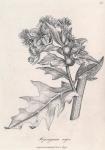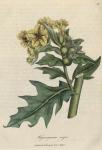
 Synonyma. Hyoscyamus. Pharm. Edinb.
Synonyma. Hyoscyamus. Pharm. Edinb.
Hyoscyamus vulgaris et niger. Bauh. Pin. p. 169.
Hyoscyamus niger. Gerard Emac. p. 353.
Hyoscyamus vulgaris, J. Bauh. iii. 627. Raii Hist. p. 711. Synop. p. 274. Park. Theat. p. 362.
Hyoscyamus. Hal. Stirp. Helv. n. 580. Stoerck Libel, de Stramonio, &c. Withering. Bot. Arrang. p. 231.
Class Pentandria. Ord. Monogynia. Lin. Gen. Plant. 247.
Ess. Gen. Ch. Cor. infundibul. obtusa. Stam. inclinata. Caps. operculata, 2-locularis.
Spec. Char. H. foliis amplexicaulibus sinuatis, floribus sessilibus.
The root is biennial, long, compact, white, and beset with many fibres: the stalk is erect, round, woody, branched, and rises about two feet in height: the leaves are large, cut into irregular lobes or pointed segments, of a sea-green colour, undulated, woolly, and at their bases embrace the stem: the flowers are produced in irregular clusters at the tops of the branches; they are funnel-shaped, consisting of a short tube, with an expanded limb, which is divided into five obtuse segments, of an obscure yellow colour, and beautifully painted with many purple veins: the calyx is divided into five short pointed downy segments: the five filaments are tapering, downy at the base, inserted in the tube of the corolla, and furnished with large oblong antherae: the germen is roundish: the style slender, longer than the stamina, and terminated by a blunt stigma: the capsule is oval, marked with a line on each side, and divided into two cells, which contain many small irregular brown seeds. It is a native of England, and grows commonly amongst rubbish, about villages, road sides, &c. and flowers in June.
"The smell of Hyoscyamus is strong and peculiar, and the leaves, when bruised, emit somewhat of the odour of tobacco. This smell is still stronger when the leaves are burnt; and on burning they sparkle with a deflagration, somewhat resembling that of nitre, but to the taste they are mild, and mucilaginous." Henbane is a powerful narcotic poison, [Haller says, Memini sodalem meum Simonium, cum Leidae mecum, anno 1725. Boerhaavii scholas frequentaret, Aconita, Apocyna, Belladonna; baccas impune devorasse, ab Hyoscyami vero semine victum, nimiae curiositatis poenas dedisse, atque mente alienatum, alteroque latere resolutum, tamen a Praeceptore servatum fuisse. Stirp. Helv. n. 580.] and many instances of its deleterious effects are recorded by different authors; [Out of the many instances of this kind, we shall only advert to some of them, in order to shew that the roots, seeds, and leaves of this plant, have separately produced poisonous effects. Dr. Patouillat, Physician at Toucy in France, relates (in the Phil. Trans. vol. 40. p. 446) that nine persons, in consequence of having eaten the roots of Hyoscyamus, were seized with most alarming symptoms; "some were speechless, and shewed no other signs of life than by convulsions, contortions of their limbs, and the risus sardonicus; all having their eyes starting out of their heads, and their mouths drawn backwards on both sides; others had all the symptoms alike; however five of them did now and then open their mouths, but it was to utter howlings. The madness of all these patients was so complete, and their agitations so violent, that in order to give one of them the antidote, I was obliged to employ six strong men to hold him while I was getting his teeth asunder to pour down the remedy." And what is remarkable, Dr. P. says, that on their recovery, all objects appeared to them as red as scarlet, for two or three days.—Further accounts of the effects of these roots are given by Wepser de Cicut, &tc. p. 230. Simon Pauli Quadr. p. 384. Blom, in Vet. Ac. Handl. 1774. p. 52.——Respecting the seeds of Henbane, we have an account given by Sir Hans Sloane, (in the Phil. Trans. vol. 38. p. 99.) of four children who ate them by mistaking the capsules, in which they were contained, for filberts. "The symptoms that appeared in all the four were great thirst, swimmings of the head, dimness of sight, ravings, profound sleep, which last in one of the children continued two days and "nights." See also Essays and Obervations, phys. & lit. vol. 2. p. 243. Helmont. Ort. Med. p. 306. Ephemer. Germ. annis 7 & 8. &c.——The leaves of Hyoscyamus, we are told, were boiled in broth, and eaten by seven persons, (five men and two women) who soon became affected with symptoms of intoxication. Dr. Stedman says, "I saw them about three hours after having eat it; and then three of the men were become quite insensible, did not know their comrades, talked incoherently, and were in as high a delirium as people in the rage of a fever. All of them had low irregular pulses, slavered, and frequently changed colour: their eyes looked fiery, and they catched at whatever lay next them, calling out that it was going to fall." Phil. Trans. vol. 47. an. 1750. For additional facts, see Haller l. c. Spielmanni Diss. de veget. ven. Alsat. Henbane is poisonous to birds and dogs; but horses, cows, goats, and swine, it does not affect.] from which it appears that any part of the plant, when taken in sufficient quantity, is capable of producing very dangerous and terrible symptoms. [Vires emollientes, & narcoticas, classis suae potentissimas possidet, ut etiam magis, quam reliquae, mentem emovere videatur, & deliria furiosa, rixosaque ciere, unde olim nomen gessit alterci. Ea deliria aliquando fugacia sunt, & temulentiae similia; alias diutius durant; & denique in mortem transeunt. Alias Hyoscyamus hominem in stuporem conjicit. Sed & sopores facit, & vertigines, convulsiones, risusque sardonios, & inflationes, strangulationes, ardorem faucium, frigus extremorum. Si alvum duxit, a resolutione aliqua toni id videtur factum fuisse. Haller l. c.] But there cannot be a doubt that this plant, like others of the same natural order, under proper management, may be safely employed, and be found in many cases to be an active and useful remedy. Hyoscyamus was well known to the ancients, and its effects as an anodyne were experienced by Dioscorides, [Lib. 4. c. 69.] and with this intention it has been used both internally and externally by several subsequent writers, particularly by Celsus; [Lib. 5. c. 25.] and in hemorrhagic diseases, the sem. Hyoscyami were successfully given by Plater, [Prax. Med. p. 635.] Forestus, [Observat. lib. 16.] and Boyle. [Usefulness of Nat. Phil, part 2.]
It appears however that for a long time past the employment of Henbane, in the practice of medicine, was wholly laid aside till Baron Stoerck published several cases of different diseases, in which an extract, prepared from the juice of this plant, had been discovered to be an efficacious remedy. [Lib. de Stram. Hyoscyam. &fc.] These diseases are stated by the Baron to be internal spasms and convulsions, palpitations of the heart, madness, melancholy, epilepsy, inveterate head-aches, haemoptysis; and a troublesome cough, which accompanied the last-mentioned complaint, was completely appeased by the repeated use of the extract, which in several disorders was often found to produce sleep more powerfully than opium. The success of Hyoscyamus in these cases, (many of which were said to be of long duration, and to have resisted the effects of other remedies) is also confirmed by Collin, who extended the dose of the Extract. Hyoscyami, to twenty-four or thirty grains per diem. [Observ. Tom. 2. p. 142.] But from the experiments made of this medicine by Greeding, who tried it in forty cases of melancholia, mania, and epilepsia, the result was very different: [Vide Ludw. Advers. Med. pr. Vol. 1. P. i, p. 71. & sq.] yet while his practice shews that no benefit is to be expected in these three diseases, it tends to prove that this medicine is a useful anodyne; and as it usually opens the body, it may be advantageously substituted for opium, where the astringency of the latter becomes an objection to its use. Dr. Cullen says, "that in epilepsy, and various convulsive affections, for which Baron Storck particularly recommends the extract of Henbane, we have very frequently employed it, but have never found it of any great virtue, nor of more than what we have found in opium. We have indeed found the Hyosciamus to be often an agreeable anodyne and soporiferous medicine; and we have frequently found it such in persons, who from particular circumstances did not agree with opium, and particularly because it was less binding to the belly than opium. We judge however that it is more ready in full doses to give delirium than opium is, and therefore we found it in many cases to give turbulent and unrefreshing sleep; and notwithstanding its laxative qualities, for which we had employed it, we have been obliged to lay it aside." [Mat. Med. vol. ii. p. 271.] Stoerck and some others recommend this extract in the dose of one grain or two; but Dr. Cullen observes, that he seldom discovered its anodyne effects till he had proceeded to doses of eight or ten grains, and sometimes to fifteen, and even to twenty.
The leaves of Henbane are said to have been applied externally with advantage in the way of poultice, to resolve scirrhous tumours, and to remove some pains of the rheumatic and arthritic kind.

